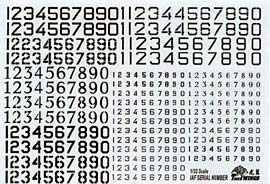Tiger Wings Decals | Israeli Air Force Kfir C1/C2/C7
Reviewed by Mark Proulx

So, how many of us have been waiting for decals to be released, which allow us to build the 1/32nd scale Kfir C 7 conversion from CAM (nee Tac Scale Dynamics)? I've had the resin conversion and Revell Mirage in the basement gathering dust, waiting for the day that someone would supply us with decals.
Well, at last, Tiger Wings has come along and supplied the modeler with what may very well be the definitive decal sheet for the Israeli Air Force Kfir in 1/32nd scale! The decal sheet is virtually for any variant of the Kfir that was ever flown by the Israeli Air Force, including the C1, C2 and C7 variants.
The decals are on four sheets, in a plastic bag. Included on the first sheet are squadron markings, national insignia and Hebrew text for the nose of some aircraft. The second sheet supplies all the stencils required for the Kfir in Hebrew. Sheets three and four are identical and include numbers from all IAF Kfirs in every size and shape. The carrier film is kept to a minimum and the printing is perfect. The decals appear to be fairly thin upon inspection. The decals look as though they could be easily applied, (although I have not tried them). I have decided to include two scans for this review, due to their size. Note: Don't let a poor resolution scan let you think it is a substandard decal sheet.

I would have preferred to see a decal included for the fin flash on the C7s of the Arava Guardians Squadron, as the resin conversion set is for a C7 Kfir. Tiger Wings recommends the colors to be used on the flash. Since the same colors are used for the flash and the crest, I hope it matches the crest Tiger Wings includes.
The instructions are printed on ten half-page segments. Tiger Wings shows in depth the paint scheme for every Kfir variant, using top and side profiles. Paint references are given using Mr. Color, however, I would have preferred to see the more common Federal Standard system used.
The instructions, in my opinion, are disappointing to the modeler. There are no instructions for the nose's Hebrew text, or the correlating serial numbers. For each Kfir variant, instructions show only the decals that are to be applied to the vertical stabilizers. They do not state which squadron belongs with which markings. Tiger Wings does, however, include two pages of instructions showing the correct placement of all the stencils. At least they did include references with the instruction sheet. The IsraDecals book, Israel Aircraft Industries Kfir by Raanan Weiss and Yoav Efrati will be an essential aid in using this decal sheet.
Overall, this is an excellent decal sheet. I would have liked to see more information about decal placement specific to a particular aircraft, given the elaborate painting instructions. With references being essential, I would rate this decal sheet with four out of five stars.
© Mark Proulx
This review was published on Saturday, July 02 2011; Last modified on Wednesday, May 18 2016
